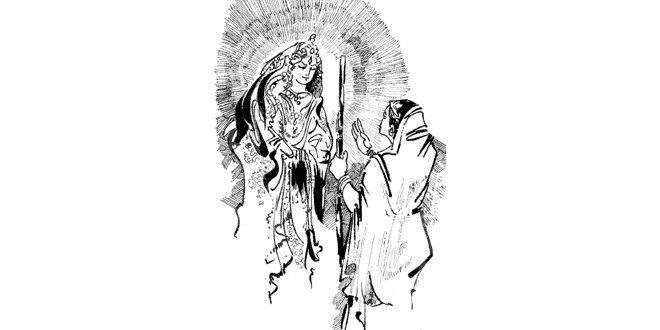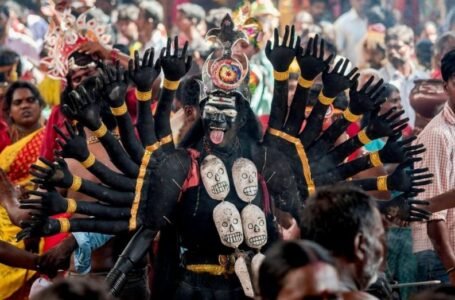The Hand of Goddess : A Tale of Transformation and Faith

-Trushti Dand
Can love and faith truly change a person’s destiny? The Hand of Goddess is a powerful folktale from Kerala that explores themes of transformation, devotion, and divine intervention. It tells the story of Kannappan, a ruthless tribal chief, whose daughter’s love leads him to abandon cruelty, eventually paving the way for the creation of a sacred temple. The tale also introduces the supernatural, featuring the terrifying Yakshi and the miraculous protection offered by Goddess Durga. This folktale serves as both a moral lesson and a cultural legend, deeply rooted in Kerala’s spiritual traditions.
Kannappan was a tribal chief in Chottakkara known for his brutality. He believed that daily cow sacrifices protected his people and stole cattle from nearby villages for this purpose. Those who opposed him faced violent retribution. Despite his ruthlessness, Kannappan deeply loved his only daughter, Thevi, who silently disapproved of his actions and prayed for his change of heart.
One day, Kannappan stole a cow and its calf. While the cow was sacrificed, Thevi grew fond of the calf and raised it as her pet. When Kannappan could not find another cow for sacrifice, he decided to use Thevi’s beloved cow. However, she courageously stood against him, saying that if he truly loved her, he should spare its life. Her words deeply moved Kannappan, leading him to renounce violence forever.
Years later, after Thevi’s untimely death, Kannappan found solace in the cow’s presence. One night, he had a divine vision, and the next morning, he discovered that the cow had turned into a stone. Believing this to be a sign from the goddess, he built a shrine dedicated to Durga. Over time, Kannappan became a saint, guiding others toward a righteous path. After his death, the shrine was forgotten and covered by dense forest.
The temple’s rediscovery came when a Brahmin woman unknowingly struck a hidden stone idol, causing it to bleed. A priest, sensing its divine presence, initiated worship, leading to the temple’s revival. The temple also became known for Durga’s power over evil spirits, including Yakshis—mystical female entities known for luring and draining the life force from travellers. In one account, a priest on his way to the temple was pursued by a Yakshi but was saved when the goddess’s divine hand emerged from the temple to rescue him.
The Hand of Goddess is deeply embedded in Kerala’s spiritual, historical, and cultural fabric, reflecting the region’s transition from tribal traditions to Hindu devotional practices. The story of Kannappan mirrors the gradual transformation of local tribal belief systems into the more structured religious practices that shaped Kerala’s cultural identity. Kannappan’s initial practice of cow sacrifice represents ancient tribal rituals, while his eventual reverence for the sacred cow aligns with Hindu values, signifying the assimilation of indigenous beliefs into mainstream Hinduism.
The establishment of the temple in Chottakkara, later recognized as Chottanikkara Temple, highlights the significance of goddess worship in Kerala. The temple became a major pilgrimage site, revered for its association with healing and exorcism, particularly for those suffering from possession by evil spirits. This connects to the folktale’s depiction of Yakshis, supernatural beings known for preying on travellers. The temple’s rituals, such as using sacred objects to ward off negative forces, continue to reflect Kerala’s longstanding belief in divine protection.
Additionally, the tale embodies the importance of devotion and transformation, themes that resonate in many Hindu stories. Thevi’s compassion symbolizes the power of love to bring about change, while the priest’s rescue by the goddess underscores faith’s role in overcoming adversity. The folktale serves as both a moral lesson and a cultural artifact, preserving Kerala’s spiritual heritage and demonstrating how folklore often intertwines with religious and historical narratives to shape community identity.
The folktale explores several profound themes that reflect moral, spiritual, and cultural values.
One of the most significant themes is transformation and redemption. Kannappan, once a cruel and violent tribal chief, undergoes a deep moral change after witnessing his daughter’s love for a calf. His shift from a merciless sacrifice of cows to a devoted worshipper of the divine showcases the power of love and compassion to inspire change.
Another central theme is faith and divine intervention. The priest’s unwavering devotion to the goddess ultimately saves him from the Yakshi. The goddess’s miraculous appearance at the temple to protect her devotee symbolizes the protective power of faith and the belief that divine forces intervene when true believers are in danger.
The story also highlights the struggle between good and evil. The Yakshi represents malevolent forces, while the goddess embodies protection and righteousness. This battle mirrors Kerala’s deep-rooted spiritual traditions, where rituals and prayers are used to ward off negative energies.
Additionally, the tale conveys the theme of sacredness of life. Thevi’s plea to her father to spare the cow emphasizes the respect for life, aligning with Hindu beliefs that all living beings, especially cows, are sacred.
Finally, cultural preservation and spiritual awakening emerge as crucial themes. The transformation of a forgotten shrine into a grand temple represents how faith and devotion can revive lost traditions and reinforce cultural identity. This folktale, therefore, serves as a moral and spiritual guide while preserving Kerala’s rich folklore.
The folktale The Hand of Goddess employs various symbols and literary devices to enhance its depth and meaning.
One of the most significant symbols is the cow, which represents innocence, purity, and divinity. Thevi’s love for the calf and Kannappan’s eventual reverence for it highlight the transformation from ignorance to spiritual awakening. The stone idol symbolizes forgotten traditions and the hidden divine presence in nature, which is rediscovered through devotion. The hand of the goddess serves as the ultimate symbol of divine intervention and justice, reinforcing the idea that faith can overcome evil.
The folktale also utilizes literary devices like foreshadowing. Thevi’s silent disapproval of her father’s cruelty hints at his eventual change of heart. Personification is evident in the depiction of the Yakshi as a supernatural entity that preys on humans, embodying the fear of the unknown. Imagery is used vividly, especially in the descriptions of the dense forests, the divine light, and the blood oozing from the idol, creating a mystical and suspenseful atmosphere.
Additionally, contrast is used between the barbaric Kannappan and his kind-hearted daughter, highlighting the power of love over cruelty. The story follows a moral allegory, teaching that transformation and redemption are possible through faith and compassion.
The Hand of Goddess carries profound lessons that remain relevant in today’s world, addressing themes of transformation, compassion, faith, and the battle between good and evil.
One of the most significant takeaways is the idea of change and redemption. Kannappan, once a cruel and violent man, transforms into a devotee through the love and kindness of his daughter. This mirrors modern narratives of personal growth, where individuals learn from their past mistakes and seek a path of righteousness. It reflects the importance of compassion over violence, reminding us that cruelty—whether to animals or humans—can be overcome by empathy and understanding.
The story also highlights the power of faith and devotion. In today’s chaotic world, where people often struggle with challenges, faith—whether in a higher power or in one’s own resilience—can provide strength and guidance. The miraculous intervention of the goddess symbolizes the belief that justice will prevail, a reassuring thought in times of uncertainty.
Additionally, the Yakshi in the story represents hidden dangers and deception, much like modern threats in the digital world—scammers, online predators, or misinformation—that lure people into traps. Just as the Brahmin is saved by the divine hand, awareness and knowledge help individuals navigate modern risks.
Ultimately, The Hand of Goddess teaches that love, morality, and faith can triumph over darkness, making it a timeless tale with deep relevance in contemporary society.


